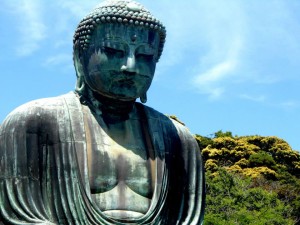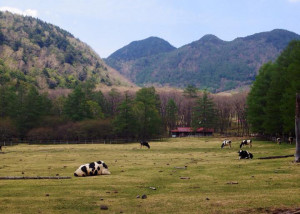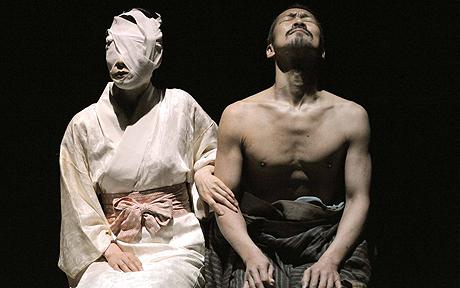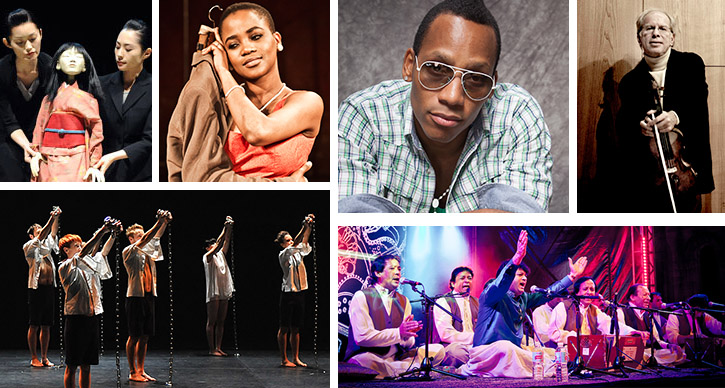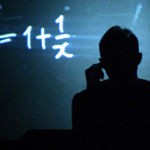Watch Online: Complicite / Simon McBurney The Encounter
Watch online May 19-25
We are excited to partner with Complicite to broadcast The Encounter online!
Described as “one of the most fully immersive theater pieces ever created” by the New York Times, The Encounter was performed live in Ann Arbor this spring following a three-month Broadway run. For a limited time, The Encounter is available for online viewing.
Audiences must wear headphones to watch The Encounter online, or the effect of the immersive binaural recording will be lost.
Sign up for email updates about future streams (choose “Arts & Culture Adventures” list).
Unlocking the Technology and Technique Behind Complicite’s The Encounter
Editor’s note: On October 2, 2016, Complicite’s The Encounter Sound Designer and Olivier Award Winner Gareth Fry visited Ann Arbor on behalf of a partnership between UMS and the Ann Arbor District Library. Jocelyn Aptowitz attended the workshop. The Encounter comes to Ann Arbor March 30-April 1, 2017.
Photo: Simon McBurney during a moment in The Encounter. Photo by Gianmarco Bresadola.
There is whisper coming from behind me. I am in Brazil, and someone is moving around me, telling me a story. I can hear the Amazon Rainforest: a mosquito buzzes in my right ear, the faint gurgle of a river up ahead.
When I open my eyes, I have not moved from The Secret Labin the basement of the Ann Arbor District Library. I am at my table; the whispering, the mosquito, and the river were all a trick courtesy of binaural sound.
Gareth Fry, the sound designer for Complicite’s The Encounter shows us only a small slice of the experience that we could expect at the performance this spring, following a three-month Broadway run this fall. It’s no wonder The New York Times calls this production “one of the most fully immersive theater pieces ever created.”
So, what is binaural sound?
One way to describe the experience of listening to a binaural recording is that it is listening in 3D. Unlike conventionally recorded sound, binaural recordings give the listener the sense of the relationship of between where the sound was produced in relation to the microphone which recorded the sound. In fact, binaural recording replicates the volume, timing, and distance of sound so perfectly that one feels immersed in that environment.
Why is binaural sound special?
A conventional microphone has no sense of space. Any sound that is recorded on a conventional microphone is generally broadcast directly back to the center of the room. Binaural recordings, on the other hand, allow the audience to use their hearing to calculate an environment around them. Humans are naturally equipped to have a very accurate sense of direction with respect to sound. Binaural sound uses shading (how our right and left ear hears sound differently) to reproduce the processing our brains automatically do for us in a given environment.
How is binaural sound recorded?
Binaural recordings are created using a binaural head, which contains a microphone in each ear. Fun fact: The binaural head was first unveiled at the 1933 Chicago World Fair by AT&T. Fry’s own head for The Encounter is nicknamed Frida, and The Encounter team flew to the Javari Valley in Brazil with their equipment to record the sounds heard in the performance.
What are the challenges associated with binaural sound?
Because binaural recordings recreate the environment of space that the sound was recorded in, it picks up a lot of ambient noise. This is a challenge for sound because all the recordings need to be very carefully captured to avoid unwanted noise. For example, when recording for The Encounter, Fry and his team had to be very careful not to whisper or use any noisy equipment while recording.
The Ann Arbor District Library has binaural recording equipment available for circulation! For more information, please email tools@aadl.org, and make your own field recording.
See The Encounter in Ann Arbor on March 30-April 1, 2017.
Student Spotlight: Rachel Stopchinski on Japan and Sankai Juku
Editor’s note: Rachel Stopchinski is a student at the University of Michigan and part of our UMS student intern team. This summer, Rachel traveled to Japan as part of a study abroad program through the University of Michigan. Her travel blog follows, and her experiences include reflections on Sankai Juku, a Japanese dance group performing in Ann Arbor this October.

Photo: A moment from UMUSUNA: Memories Before History, a work by the Japanese company Sankai Juku, who perform in Ann Arbor October 23-24, 2015. Photo courtesy of the artist.
This past May, I had the opportunity to travel to Tokyo, Japan, my second study abroad program in my undergraduate years. This program followed a class I’d taken on Environmental History. As part of the class, my classmates and our professor were going to participate in experiential learning and exploration. After studying in Tokyo for a month the year prior, I was excited to see what adventures this trip would bring me. However, I knew that neither of these trips would’ve been possible without my exposure to international theater through my internship in the UMS ticket office.
Inspired to Learn by Performance
In its 2013-2014 season, UMS presented Complicite’s A Portrait of Shun-kin, a contemporary theater work. While working in the ticket office, students familiarize themselves with upcoming performances. A Portrait of Shun-kin was one of those performances that seemed so unusual that I had to attend to grasp what it was about. Based on Tanizaki Junichiro’s novella of the same title, the performance was performed in Japanese by the Setagaya Public Theater with English subtitles and made heavy use of puppetry and highly-contrasted stage lighting. Although the performance was three hours long, I didn’t notice time passing and was spell-bound by the performance’s intensity. I walked away that night painfully aware of how little I knew about the world and of the small scope of literature that had been covered in the English courses I’d chosen so far. Coincidentally, this is when I heard about a new study abroad program focused on reading modern Japanese literature in translation…It was fate. Had I not had that exposure through A Portrait of Shun-kin, I don’t believe I would’ve found myself in Tokyo that following year with a growing interest in Japanese culture and history. In literature, context is everything, and I wanted to explore Japanese history in a practical way.
Left: Daibutsu at Koto-kuin, a Buddhist Temple in Kamakura, Japan. Right: A view of the seaside in Kamakura, Japan.
Returning to Tokyo
For me, returning to Tokyo for the second time brought the realization that while one may leave a place, one never really forgets it. I’d spent my time on my first trip freely exploring the city, so during the second trip, I easily adapted to using the trains and metro again. (I even felt a little nostalgic.) But though my directional memory was spot on, the second trip came after one more year of learning about Japan, so I viewed the city through a different lens.


Left: The Tokyo skyline as seen from Tokyo Tower contrasted with Right: A serene bridge inside Koishikawa Korakuen, a traditional Japanese garden in Tokyo.
Through my Environmental History course, we studied the effect of environmental issues on Japanese culture and history over time. During my time in Japan, we interacted with many people, from university students to filmmakers, non-profit organizations, and even government officials at a waste processing site, all with the purpose of learning about the environmental issues. During the program, we moved to and from the countryside, meeting guides who taught us about the unique history and traditions of the places we visited and highlighted the longstanding relationship with the environment, both its great beauty and the effects of devastating pollution and disasters. We explored the harmony and disharmony between humans and nature.
Left: A pastoral scene found while hiking in Nikko, Japan. Right: Basking in the beauty of Lake Chuzenji from a swan boat.
Back to Performance
When looking at the description for UMS’s upcoming presentation of Sankai Juku’s UMUSUNA: Memories Before History, I think about hiking in ancient, old growth forest in the “sea of trees” at the base of Mt. Fuji. My class was spending the weekend in Fujinomiya, Japan at the Whole Earth Nature School, an organization that facilitates groups in “ecotourism.” Our guides, Michi and Musashi, stressed the importance of engaging with the environment, so while we learned about Mt. Fuji as an active volcano and this history of the plant growth form observation, we got dirty, hugged a few trees, and went caving as well.
I’m not sure that we could have been prepared for the ice in the cave. Everything from the floor to walls to ceiling was covered with a thick layer of ice. We tried to avoid it but conceded to sitting down and sliding throughout. It was a challenging experience. We tried our best to work as a team to identify those least icy parts. When we reached a clearing in the cave, we turned off our head lamps and sat in darkness, deep below the earth we had once stood on. Climbing out of the cave, we moved from darkness to light and the most vivid colors I’d ever seen. I won’t forget both the reverence I felt in that cave and the joy upon reaching the surface.
Butoh performance, like Sankai Juku’s UMUSUNA: Memories Before History, which plays at the Power Center this October, often aren’t narrative. The symbolism of their intense movement vocabulary is left for the audience to decipher. I expect this performance will call to my mind my experiences both in the forests of Mt. Fuji and elsewhere, experiences that attempted to illuminate the complex relationship between Japanese culture and the environment. We interacted, even climbed inside, the earth. We wondered what it would have been like before human interaction—a history we can only imagine.
Interested in more? From our archives, backstage with Sankai Juku.
Between servant and mistress, over and over
Editor’s note: This essay is by Simon McBurney, director of British theater company Complicite. Complicite performs Shun-kin with Setagaya Public Theatre in Ann Arbor Septer 18-21, 2013.

Photo by Brookie (own work) via Wikimedia Commons.
In Japan, sometimes, it is hard to know what you are looking at.
I gaze at the symbols beside me, my underwear still around my ankles. There are at least ten. It is the one to flush I am looking for. Not the one that sprays perfume in the bowl, or worse still sprays to ‘clean’ from various angles and intensities, nor the one that blows hot air to dry you afterwards or plays the sound of tinkling water when you urinate so no one outside the door can hear you. Nor the one that heats the seat although I must have already pressed it because I feel my nether regions are cooking the longer I sit here. No. I simply want to push the one that will flush. The toilet is made of one piece of pressed plastic of a worrying flesh color. In fact the whole of the room is made from a single piece of plastic, no joins anywhere. Easy to clean I imagine. For one moment I wonder if there is a button that will set off a tsunami of cleansing product to sluice the entire room. I hesitate with my finger over the icons.
“…the Japanese toilet truly is a place of spiritual repose. It always stands aside from the main building, at the end of a corridor, in a grove fragrant with leaves and moss. No words can describe that sensation as one sits in the dim light, basking in the faint glow reflected from the shoji, lost in meditation or gazing out at the garden…surely there can be no better place than a Japanese toilet where…[one] looks out upon blue skies and green leaves. There are certain prerequisites: a degree of dimness, absolute cleanliness, and quiet so complete one can hear the hum of a mosquito. I love to listen from such a toilet to the sound of softly falling rain, especially if it is a toilet in the Kanto region…Compared to Westerners, who regard the toilet as utterly unclean and avoid even the mention of it in polite conversation, we are far more sensible and certainly in better taste…our forebears, making poetry of everything in their lives, transformed what by rights should be the most unsanitary room in the house into a place of unsurpassed elegance, replete with fond associations with the beauties of nature.”
So wrote Jun’ichiro Tanizaki in his 1933 essay on aesthetics entitled In Praise of Shadows. But here in 2008, gazing at the buttons at the side of my all-in-one plastic computer loo on the 22nd floor of my Tokyo high-rise, I would be hard pressed to term this “…a place of unsurpassed elegance, replete with fond associations with the beauties of nature.” And when, finally, I take the plunge and press on a button with what seems to be an icon for “flush”, I am electrified by the powerful spurt of extremely hot water in a delicate area of my anatomy.
When I first read In Praise of Shadows in 1996, I was rapt. As Charles Moore says in his introduction: “It comes with the thrill of a slap for us to hear praise of shadows and darkness…darkness (which) illuminates a culture very different from our own; but at the same time allows us to look deep into ourselves to our own inhabitation of the world…”
Our inhabitation of the world
Our inhabitation of the world: where light is synonymous with progress. We talk, in the West, of “enlightenment’ as a term of understanding. Yet the understanding that Tanizaki requires us to engage in, is another way of looking, to see something in the unknown, seeing beauty in shadow and darkness.
“The quality we call beauty, however, must always grow from the realities of life, and our ancestors, forced to live in dark rooms, presently came to discover beauty in shadows, ultimately to guide shadows towards beauty’s ends.”
A Westerner, Tanizaki suggests, has no sense of how the blackness of the lacquer bowl is beautiful precisely because you cannot see the soup within. You must divine what is in it by closing your eyes and smelling; you must imagine, see without seeing. “What lies within the darkness one cannot distinguish, but the…fragrance carried upon the vapor brings a delicate anticipation.”
The beauty of an old pot, for example, is enhanced because age has darkened it and time cracked its perfection. Its imperfection is an essential part of its beauty suggesting a life lived, rather than a goal achieved.
And if you really want to meet your love, then the best place is in the very heart of a Japanese house where the light almost does not penetrate, and where to make herself even more beautiful the woman of your dreams blackens her teeth. This last image an anathema to us, given our obsession with the white plastic smile.
I personally, however, am quite focused on achieving a goal as I walk out into the street on my day off here in Tokyo. I can think of nothing except the project of bringing Tanizaki’s words to life, which is particularly worrisome as his works are regarded as classics. This is not something a foreigner should necessarily get his hands on, particularly if he does not speak Japanese. And right now I am surrounded by concrete and neon. Not wood and paper. At least I gave up some years ago thinking I could simply use this polemic on darkness, In Praise of Shadows, as the only text. I thought there must be something the audience could look at if it were to be played in a theatre. And so I was pointed towards A Portrait of Shun-kin.
A Portrait of Shun-kin
In 1933, at the same time as publishing In Praise of Shadows, Tanizaki writes another story about seeing without seeing. A Portrait of Shun-kin. The story of Shun-kin; the true account of a blind female shamisen player and composer who lived in the mid-19th century. Unconventional and ravishingly beautiful, the musician Shun-kin lived with her servant, Sasuke. At first simply a serving boy whose duty it was to lead her around, he later became her pupil and then her lover; it is a shadowy love story that places at its center the power of the imagination in darkness. Because Shun-kin was blind, her servant Sasuke, in his desire and love to inhabit Shunkin’s world, blinds himself. The story begins with the facts:
“Shun-kin (born as Mozuya Koto, but better known by her professional name) was the daughter of an Osaka drug merchant. She died on the fourteenth of October in 1886 – the nineteenth year of the Meiji Era – and was buried in the grounds of a Buddhist temple of the pure land sect in the Shitadera district of Osaka.”
The style is that of highly detailed scholarly research into the life of this remarkable and distinguished 19th-century composer and musician. Sunk in the sensual dimness of the world of In Praise of Shadows, and dealing with another kind of darkness, that of the eroticism of mistress and servant, I fell for it. I decided to do some research of my own. So I googled Shun-kin.
But I guess I should have known when first starting out on this project nearly ten years ago, that if I could not work out the symbols on a plastic toilet, how could I possibly grasp the subtleties of the Japanese text obliterated by translation. Shun-kin is, of course, Tanizaki’s creation and never existed. But, I am happy to say, I was not the only one to have been taken in by the authentic tone of Tanizaki’s mock documentary style. Much of the critical establishment in Tokyo at the time was similarly flummoxed.
Pseudo-documentary ‘fact’ in A Portrait of Shun-kin is developed in extraordinary detail. The effect is to create a densely textured world where it is almost impossible not to accept that the figure of Shun-kin is an historical figure. Indeed we wonder where this is all going as the facts amassed seem to distance us from the emotional heart of the story itself. Nothing is clear.
Nothing is clear to me either as I wander the streets of Ikebukuro after my unfortunate affair with the toilet. The intensity of the streetlight seems to make a mockery of the idea that “darkness” should be celebrated in a meaningful way as Tanizaki writes. I begin to feel, not for the first time, that In Praise of Shadow is merely an exercise in historical nostalgia. Worse still a kind of nationalistic call for a specific cultural distinction in the jingoistic atmosphere of Japan in 1930. And maybe A Portrait of Shun-kin is merely an excuse for him to delve into his own perverted fantasies about submissive men and dominant women. Not for the first time in this extraordinary country I feel lost.
Across the road from me people are pouring out of a club. I watch fascinated as a group of young women chatter and laugh and hang out. Of course this sight in itself is not strange. It is only that they are all carrying violin cases and are dressed as Little Bo Peep. All of them. Like walking versions of the fake Delft porcelain shepherdesses that I saw aged nine in the windows of bed-and-breakfast lodgings when we went on holidays to the seaside. I sneak nearer to see what this is all about. One of them opens her case to show to another. I am close enough to see inside. There, nestling among the purple violin-protecting velour, is a doll. An exact replica of the girl who is showing her to her friend. The same bonnet, the same ruffled dress hoicked up to show the same white little girl stockings. Even the face has been replicated. Or has the girl’s face been made up to replicate the doll. It is not clear.
A severe problem in translation
In Japan, sometimes, it is hard to know what you are looking at.
For not only is the story of Shun-kin a series of strange fake documentary fragments, but its origin is not Japanese at all. Tanizaki took the idea from a Thomas Hardy short story in a collection entitled Some Noble Dames. The story in question rejoices in the title of Barbara of the House of Grebe. In this tale is also a narrator who pieces together the story from various sources, using guess work, and also quoting from so-called accounts of the period. It also evokes a vanished historical period, and then explores a sado-masochistic relationship, with scenes of terrible mutilation and its effect on that liaison. But there the comparison ends. The masochism in Tanizaki is, unlike the Hardy, a positive thing. Not merely because he was a masochist himself. But perhaps because such “perversions” do not carry the same stigma in Japan. “Kinky” relationships are allowed to unfold, at least in Tanizaki’s texts, with none of the same anxious guilt we in the West might have about such things. And in A Portrait of Shun-kin everything is distanced by this dense and complicated narrative technique.
Only while reading aloud with the actors did I become aware of a severe problem in translation. But one that, ultimately, opened a door on to what Tanizaki was doing in the original Japanese. I had asked the actors to pause at the end of sentences, only to find that I appeared to have a rebellion on my hands.
“What’s going on?” I asked.
I was met with a polite silence and then my translator Manabu Noda pointed out, “There are no full stops.”
“What?”
“No short phrases to quicken the narrative. His writing here is consciously recalling an archaic Japanese style.”
Perversion in narrative
Meandering and crossing one event into another the narrative itself does not progress, as it does in Hardy’s tale, to actions where we want to know what will happen next, where we wait for the “frightful consequence.” On the contrary, Tanizaki seems to deliberately subvert the idea of such an approach. In vain did we try to imagine there was more action and when we started to rewrite the whole text everything began to fall apart. The rehearsal ground to a halt. And we went home for the weekend.
I was thinking of what we would do next as I left the shepherdesses and wandered despairingly among the interconnected infinite miles of shopping malls in Ikebukuro. To be frank, and not for the first time, I wondered if we would be able to make anything at all. There was nothing to do but to submit to what was there. OK so the scenes repeated over and over rather than driving a narrative forward. But surely this was the point. A rhythm was established. An atmosphere poetically evoked. A perverse relationship examined and excavated. And as Slavoj Zizek puts it: “…in perversion the narrative remains stuck in the same place and repeats itself indefinitely – that is to say, the perverse narrative is unable to “progress” properly.” Perhaps this was Tanizaki’ s intention.
Shun-kin and Sasuke seem to re-enact a series of rituals, which lead to the climax of Sasuke blinding himself. They work as a kind of music might do. Building in waves of intensity. Using the interwoven voices, voices of narrative, not dialogue. In the dramatic situations there is nothing to say between them. They are sometimes not even dramatic. There is only the relationship of mistress and servant. It is a play of actions. The same actions. Over and over. Leading. Washing. Dressing. Cleaning. Obeying. Ordering. Time passes. Time wears. The faults begin to show. And then, only then when the worst can happen, just as the pot only becomes beautiful when it has a crack in it, is the real beauty and intensity of this relationship revealed.
However, nothing is sure; nothing is completely clear; even in this climax. Who disfigures Shun-kin? Why did Sasuke not hear the intruder who disfigures her entering her room, given that he has slept all his life in the next room? Tanizaki even emphasizes this by giving us several different accounts of what happened. Each telling a different version of events.
There is only something to be felt
The only way to approach it is to embrace such uncertainty. So given they, both Shun-kin and Sasuke, are narcissists who are so obsessed with each other they even give up their children for adoption, we could imagine anything. We could even imagine that Sasuke disfigures Shun-kin himself in order to incorporate her more perfectly into his fantasy world. And in blinding himself, that fantasy becomes perfect. But stop speculating my cast tells me. It is precisely the author’s intention that we should be left in ambiguity. There is nothing to be “illuminated,” to be made clear in the English sense of narrative drive. There is perhaps nothing even to ‘understand’, there is only something to be felt. Trust what happens when you read it. When you read the story, the moment of their coming together in their blindness is extraordinary. And it is given in the words themselves. Take the narrative voices away and something falls to bits.
To play the situations of the story without the sprawling sentences that interlock like an intricate piece of Japanese architecture would be to destroy the nature of the tale. The perverse character of Shun-kin is revealed within the convoluted syntax itself, as is the tangled pain of Sasuke’s adoration. In order Japanese prose there was a minimum of full stops. And as my cast pointed out to me, it is no accident that the sentence recounting Sasuke’s blinding is the longest in the book. Ah, so it was not surprising that I had no idea of what he was getting at. Because in the English version, this sentence is translated in neat short phrases. Almost as if it were ‘clarifying’ or illuminating the original. But that was not Tanizaki’s intention. He was creating obscurity. Shadows. To evoke the sense of impending blindness he expressed the tortuous and gathering darkness in the very fabric of the words themselves.
I step onto one of the endless escalators in the labyrinthin shopping center. Coming down the other way are the shepherdesses with their violin cases. Some chattering. Behaving as if there were nothing strange in what they are wearing at all. Beyond them is a vast window into the street. Snow is falling. In Japan it is hard sometimes to know what you are looking at.
“The quality we call beauty, however, must always grow from the realities of life…”
And there is for a moment something exquisitely beautiful about this sight. It is there for a moment. And then it is gone. Forever.
Complicite performs Shun-kin with Setagaya Public Theatre in Ann Arbor Septer 18-21, 2013.
UMS Book Club with Nicola’s Books
New this season, UMS is kicking off UMS Book Club. UMS and Nicola’s Books have teamed up to assemble a list of fiction, poetry, and non-fiction, matching six performances with books that carry similar themes, messages, or character traits. Get reading and dig deep into elements of the performance.
Here’s how to join
Pick up a book from the UMS Book Club list at Nicola’s Books (at a special discount of 15%) and unlock a special offer of up to 25% off to the related performances. Nicola’s Books is located at 2513 Jackson Avenue, Westgate Shopping Center, Ann Arbor, MI 48103.
You can use the code online at ums.org. You can also call our UMS Ticket Office at 734.764.2538 or visit the Michigan League Ticket Office. Be sure to mention the the promo code at the start of your order.
This offer is not valid on previously purchased tickets, in conjunction with any other offer, or at the door on the evening of the performance.
The books
 Book: Seven Japanese Tales by Jun’ichirō Tanizaki
Book: Seven Japanese Tales by Jun’ichirō Tanizaki
Performance: Complicite: Shun-kin, September 18-21, 2013 at Power Center
Inspired by the work of one of the most important Japanese writers of the 20th century, Jun’ichirō Tanizaki, Shun-kin tells a tale of devotion, passion, and power, where beauty is unforgiving and love is blinding.
 Book: The Age of Miracles by Karen Thompson Walker
Book: The Age of Miracles by Karen Thompson Walker
Performance: Ballet Preljocaj, November 1-2, 2013 at Power Center
And Then, One Thousand Years of Peace, which will be seen only at UMS, BAM, and Minneapolis, was first created by Angelin Preljocaj for the Bolshoi Ballet in 2010 and takes inspiration from the vision of apocalypse conjured by St. John in the biblical Book of Revelation. Karen Thompson Walker’s acclaimed novel is about a quieter apocalypse, when the Earth’s rotation slows, is a coming-of-age tale that clings to hope in light of a collapsing world.
 Book: Shostakovich: A Life Remembered by Elizabeth Wilson
Book: Shostakovich: A Life Remembered by Elizabeth Wilson
Performance: Kremerata Baltica, February 6, 2014 at Hill Auditorium
Kremerata Baltika will perform Shostakovich’s Anti-formalist Gallery, a dangerously satirical cantata never intended to be published or performed, as it would have imperiled his safety. In her biography of the composer, Elizabeth Wilson covers the discrepancies between Shostakovich’s public image and private life “from his early successes to his struggles under the Stalinist regime, and his international recognition as one of the leading composers of the twentieth century” through the reminiscences of his contemporaries and his personal writings.

Performance: Théâtre des Bouffes du Nord: The Suit, February 19-22, 2014 at Power Center
Peter Brook’s tender production makes Can Themba’s tightly crafted, unsettling fable sing. African melodies and Schubert lieder thicken the air of this apartheid-era summer in which a shared wound is not allowed to heal. This collection of stories from the African continent, presenting many different visions of Africa and reflecting on the continent’s tragic, imperialized history, includes Can Themba’s fable.
 Book: Tropicana Nights: The Life and Times of the Legendary Cuban Nightclub Paperback by Rosa Lowinge
Book: Tropicana Nights: The Life and Times of the Legendary Cuban Nightclub Paperback by Rosa Lowinge
Performance: Alfredo Rodríguez Trio and Pedrito Martinez Group, March 14, 2014 at Michigan Theater
This double-bill performance features percussionist and vocalist Pedrito Martinez, who incorporates the folklore of his Cuban roots with religious Yoruba chants and batá melodies into the traditional clave beat of popular Latin jazz, and Cuban-born Alfredo Rodríguez, a young pianist of astonishing virtuosity and imagination, performs with the open spirit of a culture rooted in dancing. These musicians represent a new generation of Cuban-influenced music, while Rosa Lowinge’s Tropicana Nights is a window into the culture and history of pre-Revolutionary Cuba through Havana’s notorious Tropicana nightclub, an estate frequented by legends like Nat “King” Cole, Liberace, Josephine Baker, and Ernest Hemingway.
 Book: The Essential Rumi
Book: The Essential Rumi
Performance: Asif Ali Khan Qawwali Music of Pakistan, March 21, 2014 at Rackham Auditorium
If the late, great Nusrat Fateh Ali Khan (1948-97) was known as “the emperor of Qawwali,” Asif Ali Khan — who was once hailed by the maestro as one of his best students — has surely emerged as the music’s reigning prince. Asif is a superstar in his native Pakistan and a powerful figure on the international stage, remaining faithful to the sublime traditions of devotional Sufi music. Rumi is perhaps the most well-known exponent of Sufi poetry; both spiritual and carefully crafted, these poems aim to reveal the human soul.
Did you read one of these books and attend the related performance? Share your thoughts or questions in the comments below.
Renegade Artists in 2013-2014
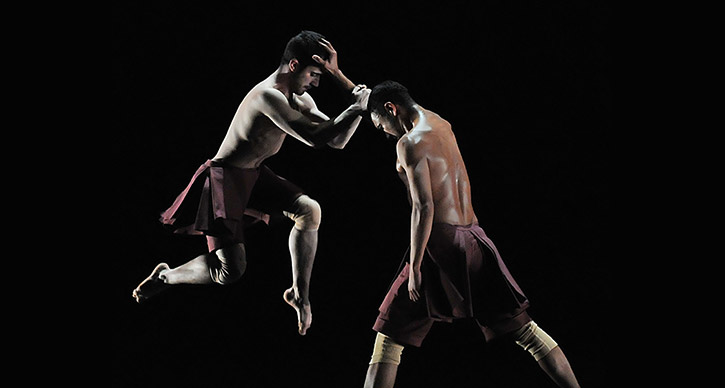
Photo: From “And then, one thousand years of peace” by Ballet Preljocaj. Photo by JC Carbonne.
Artists engage daily in a creative enterprise full of risk-taking, experimentation, and boundary pushing. Renegade is about artists who, in their own time and context, draw outside the lines, changing our expectations.
Complicite & Setagaya Public Theater: Shun-kin – September 18-21
With director Simon McBurney, you can expect the full box of theatrical tools — text, music, imagery, and action — put in service to big ideas that create surprise, confusion, and disruption. The result is anything but an expected night in the theater. These are experiences which last a lifetime. (Michael Kondziolka, UMS Director of Programming) Learn more
Ballet Preljocaj – November 1-2
Dance-theater (tanztheater), a 20th-century invention primarily attributed to the German expressionists, pushed audiences’ expectations about what a dance would look like, intentionally distancing itself from the traditions of classical ballet. Its aspiration: that, through dance, all artistic media would be united and achieve an all-embracing, radical change in humankind. Angelin Preljocaj’s work lives within and expands this experimental lineage. (Michael Kondziolka, UMS Director of Programming) Learn more
Steve Lehman Octet – November 9
Composer and saxophonist Steve Lehman is trailblazing new computer-driven models for improvisation, resulting in striking new harmonies. With his Octet, Lehman has achieved the first fully realized exploration of spectral armony in the history of recorded jazz. (Mark Jacobson, UMS Senior Programming Manager) Learn more
Colin Stetson – January 15-16
Colin Stetson, who performs unbroken 10-minute-plus compositions for unaccompanied bass and alto saxophones via a combination of circular breathing, overtones, and amplified vocalizations, expands the boundaries of what was previously thought possible for solo performance. (Mark Jacobson, UMS Senior Programming Manager) Learn more
Kronos Quartet – January 17-18
For nearly 40 years, the Kronos Quartet has pursued a singular artistic vision, combining a spirit of fearless exploration with a commitment to continually re-imagine the string quartet experience. They started out as classical chamber music’s original renegades and continue that cause to this very day. Two different programs explore their take on 40 years of renegade music-making, anchored by the piece where it all began — George Crumb’s Black Angels, a highly unorthodox, Vietnam War-inspired work featuring bowed water glasses, spoken word passages, and electronic effects. (Michael Kondziolka, UMS Director of Programming) Learn more
Kremerata Baltica and Shostakovich – February 6
With Kremerata Baltica and Gidon Kremer
It is hard for any of us to imagine what it means to be denounced publicly by the highest officials of one’s own government — especially during a time when everyone pretty much understood that this kind of admonishment could lead to a life of hard labor or worse. Dmitri Shostakovich not only carried on, but continued to create a body of art that pushed right back, albeit in coded and subversive ways. As a composer, he worked within an expected tradition; as a human, he raged against all manner of censorship and injustice. Shostakovich’s Anti-formalist Gallery was a dangerously satirical cantata never intended to be published or performed, as it would have imperiled his safety. During the composer’s lifetime, the work was performed only for family and close friends; it did not receive its first public performance until January 1989, 14 years after his death. (Michael Kondziolka, UMS Director of Programming) Learn more
Who are your favorite “renegade” artists or performers? Which performances from this list are you excited to see?
UMS Announces Additions, Changes to 10/11 Season
The 10/11 UMS season opens one month from today with the site-specific theater work Susurrus at the Matthaei Botanical Gardens.
During our summer performance hiatus, we’ve been quite busy at UMS, closing out the 09/10 season and preparing for the 10/11 events. We’ve also been working to add some exciting events to the 10/11 lineup that came together too late for the initial announcement in April:
ASSI EL HELANI, Saturday, November 6 at 8 pm, Hill Auditorium. This Lebanese pop singer has been a major figure in the music scene of the Middle East since the 1990s, participating in numerous important musical events throughout Europe, the Arab World, and America. Also involved in humanitarian concerns, he is one of the true superstars to emerge from Lebanon. Tickets range from $10-$60 with a limited number of $150 VIP seats available.
NATIONAL THEATER LIVE, co-presentation of high-definition broadcasts with the Michigan Theater. Last season, UMS and the Michigan Theater joined forces to present high-definition broadcasts of three plays from the National Theater in London. The series was a big hit with audiences, and we’re delighted to announce an incredible line-up of six productions for the 10/11 season, which includes Complicite’s A Disappearing Number, which UMS brought to Ann Arbor two seasons ago. The titles include:
A Disappearing Number, directed by Simon McBurney in association with Complicite. Sunday, October 31, 2 pm.
Hamlet, directed by Sir Nicholas Hytner with Rory Kinnear in the title role. Sunday, January 2, 2 pm.
FELA! Directed by Bill T. Jones, direct from Broadway. The Tony Award-winning musical about the extravagant, decadent, and rebellious world of Afrobeat legend Fela Anikulapo Kuti explores his controversial life as an artist, political activist and revolutionary musician. Sunday, January 30, 2 pm.
King Lear, directed by Michael Grandage with Derek Jacobi in the title role, in association with the Donmar Warehouse and featuring the creative team behind the company’s recent Broadway hit about Mark Rothko, Red. Sunday, February 20, 7 pm.
Frankenstein, directed by Danny Boyle (Slumdog Millionaire, Trainspotting). Wednesday, April 6, 7 pm.
The Cherry Orchard, directed by Howard Davies and starring Zoë Wanamaker as Madame Ranevskaya. Sunday, July 17, 7 pm.
DATE CHANGES
Mariachi Vargas de Tecalitlán Date Change. To accommodate the addition of Assi El Helani, as well as youth performances for schoolchildren, the date of the public concert for Mariachi Vargas de Tecalitlán has been changed to Friday, November 5 at 8 pm – one day earlier than previously announced.
Kodo Date Change — FAMILY PERFORMANCE ONLY. The FAMILY PERFORMANCE of Kodo will take place on Thursday, February 24 at 11 am, not Wednesday, February 23 as published in the series brochure. The public performance of Kodo will still take place on Wednesday evening as previously announced.
Single ticket brochures will be mailed in about a week (don’t forget – the internet on-sale date is Monday, August 23, with phone and walk-up orders on Wednesday, August 25. Donors of $250+ may purchase beginning Wednesday, August 18!).
31 days to the start of the season…let the countdown begin!


